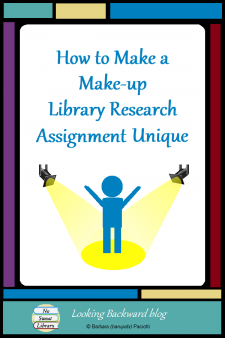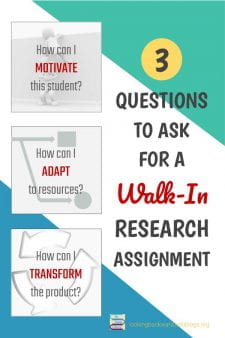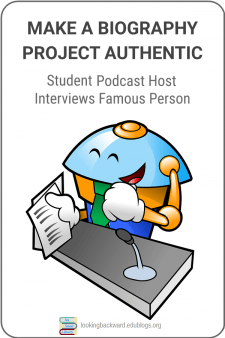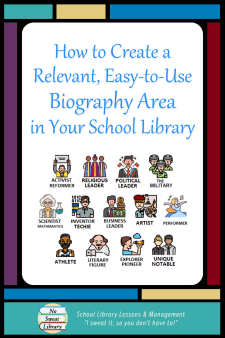 Many School Librarians have reorganized the Fiction area of their library into topical categories so students can more easily find what they like to read. Whether you call them Fiction Subjects (as I do) or genres (as do others), that reorganization is a huge boost to student reading satisfaction and to our book circulation—a success that prompts us to look at other areas we can make our school library more user-friendly.
Many School Librarians have reorganized the Fiction area of their library into topical categories so students can more easily find what they like to read. Whether you call them Fiction Subjects (as I do) or genres (as do others), that reorganization is a huge boost to student reading satisfaction and to our book circulation—a success that prompts us to look at other areas we can make our school library more user-friendly.
The ABC order of Biography by the last name of the person written about, much like the ABC order of Fiction by author’s last name, works fine if you know exactly who you’re looking for, but if you just want anyone in a particular profession—like an artist or scientist or athlete or world leader—it’s not very useful.
While most school libraries can access online subscription services like encyclopedias and biography databases, many teachers still like students to get information from a book, especially at middle and elementary levels. If your content-area teachers regularly assign students a biography project, then reorganizing the Biography area into topical categories makes it more relevant to curricular needs and easier for students to find what they need.
DECIDING TO RE-ORGANIZE BIOGRAPHY
Would reorganizing the Biography area be worth the effort? Which content-area teachers give a biography assignment with books? Since our school library’s whole purpose is to support curriculum, we first find out which occupations our teachers want students to explore.
For example, our 6th grade math teachers assign a mathematician biography project, science teachers at one grade level assign scientists, at another grade level they specify inventors. Texas History teachers assign a Texas explorers project, and an ELA teacher assigns her G/T classes a Renaissance biography project on the above topics, along with politics, religion, and the arts.
The first time I had to gather books for those assignments, I thought a topical organization would make that task much easier. It would also be it easier to determine gaps and what purchases would make the Biography collection better. Accordingly, when our ELL teacher wanted newcomers to do a biography project on all the U.S. presidents, I purchased a complete easy-reader collection of them which we used for years—and they were useful, too, with special ed students.
Curricular support is paramount, but it’s also important to support student reading with books on the people they like. And while teachers prefer longer books for student projects, most students prefer to read shorter books about the popular figures of the day. Middle school boys especially love sports figures, whereas girls prefer singers, musicians, performing artists.
Early on, students would ask me where sports and arts biographies were, so even without topical reorganization, I moved all biography books with fewer than 100 pages into the Dewey section, with the DDC number and -092 as the new call numbers. We now had a large collection of “favorite biographies” where students could easily find them, and the Biography area retained the longer books for project assignments. Advantageously, I can weed the shorter, less expensive popular books more frequently and replace them with the current idols to keep students happy.
CHOOSING BIOGRAPHY CATEGORIES
After surveying teachers and students—and browsing the biography books—you can decide on several different careers/professions for dividing up the books. Here are my choices that may help you with reorganizing your biography collection:
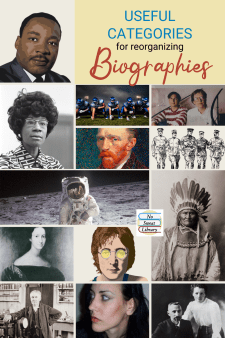 Activists & Reformers
Activists & Reformers- Religious Leaders & Philosophers
- Politicians & World Leaders
- The Military: Army, Navy, Air Force, Marines, Coast Guard
- Scientists & Mathematicians
- Inventors & Technology Innovators
- Business Leaders
- Artists: Painters, Sculptors, Architects, Graphic Designers
- Performers: Musicians, Singers, Actors, Dancers
- Athletes & Sports Figures
- Literary Figures: Writers, Poets, Dramatists
- Explorers & Pioneers
- Unique Notables (for those that don’t fit the above categories)
You may notice the order of these topical divisions is similar to Dewey Subjects, which students already recognize, and that makes them excellent choices to reorganize Collected Biographies, too. There actually is an “Option A” in the DDC Handbook for this—Dewey numbers 920-928—so I reorganized the 920s this way, and circulation of these books skyrocketed!
As with Fiction, I refer to these topical categories as “Subjects” to reinforce with students how to search in the online catalog, and I introduce these Biography Subjects as the careers or “professions” of the people the books are about. This explanation is well received and understood by middle schoolers.
LABELING BIOGRAPHY SUBJECTS/PROFESSIONS
Once we’ve chosen the biography subjects, decide how to identify them on the books and group them on the shelves. Unlike the numerous commercial labels for fiction subjects, and even for Dewey, there aren’t classification labels for different biography subjects (although Demco does have a set of 6 for inventors, sports, and the various arts).
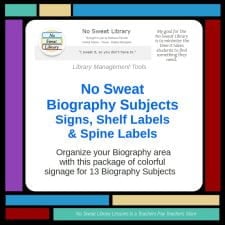 Some folks can create simple text labels and coordinated signs, but I like very visual signage that catches the eyes of students and leaves a strong impression. Using free templates for various sized office supply sticky labels, I create spine labels and shelf labels, and make bookcase signs with a slide presentation app. You may want to save yourself time and get my Biography Signs, Shelf Labels, & Spine Labels, from No Sweat Library, my TeachersPayTeachers store.
Some folks can create simple text labels and coordinated signs, but I like very visual signage that catches the eyes of students and leaves a strong impression. Using free templates for various sized office supply sticky labels, I create spine labels and shelf labels, and make bookcase signs with a slide presentation app. You may want to save yourself time and get my Biography Signs, Shelf Labels, & Spine Labels, from No Sweat Library, my TeachersPayTeachers store.
Once the labeling is done and the books grouped into their professions, we can let teachers and students know that the biography area now has a more welcoming organization system. Even if there is no current assignment, students will enjoy browsing the new layout and checking out books they never before realized we had!
Need ideas for Biography projects? Stay tuned…I’m working on some great ones!


